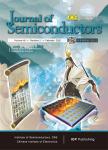Model of NBTI combined with mobility degradation
Model of NBTI combined with mobility degradation作者机构:The Shenzhen Key Lab of Advanced Electron Device and IntegrationECE PKUSZ College of Electronic Science and Technology Shenzhen University
出 版 物:《Journal of Semiconductors》 (半导体学报(英文版))
年 卷 期:2018年第39卷第12期
页 面:141-146页
核心收录:
学科分类:0809[工学-电子科学与技术(可授工学、理学学位)] 08[工学]
基 金:Project supported by the Shenzhen Science and Technology Project(Nos.ZDSYS201703031405137,JCYJ20170810163407761,(JCYJ20170818114156474) the PhD Start-up Fund of Natural Science Foundation of Guangdong Province(No.2015A030310499) the China Postdoctoral Science Foundation Funded Project(No.2015T80023)
主 题:NBTI mobility degradation aging simulation algorithm hot carrier injection self-heating effect coupling
摘 要:The mobility degradation induced by negative bias temperature instability(NBTI) is usually ignored in traditional NBTI modeling and simulation, resulting in overestimation of the circuit lifetime, especially after longterm operation. In this paper, the mobility degradation is modeled in combination with the universal NBTI *** coulomb scattering induced by interface states is revealed to be the dominant component responsible for mobility degradation. The proposed mobility degradation model fits the measured data well and provides an accurate solution for evaluating coupling of NBTI with HCI(hot carrier injection) and SHE(self-heating effect), which indicates that mobility degradation should be considered in long-term circuit aging simulation.




